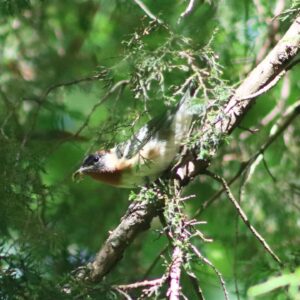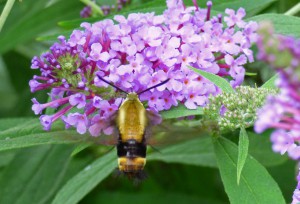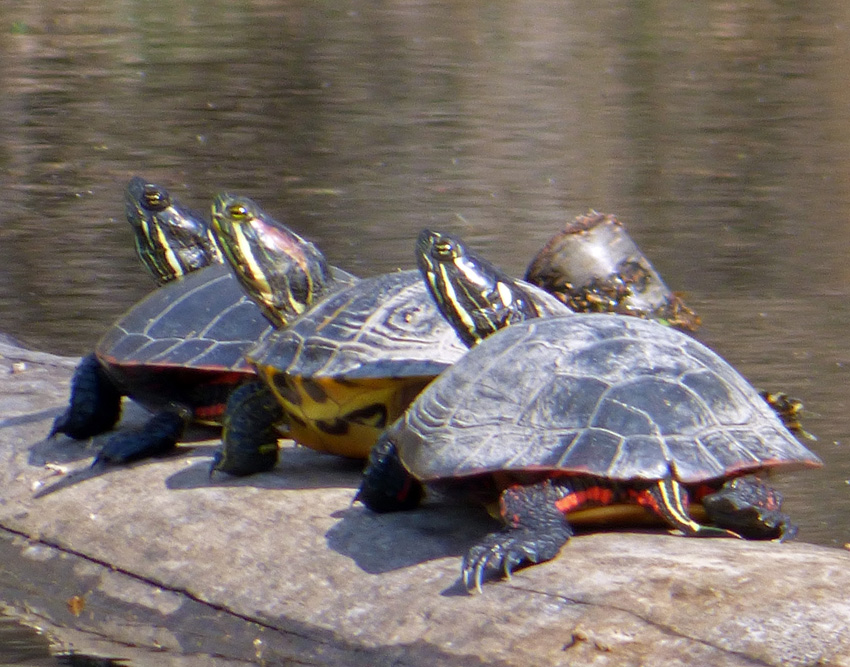 On a sunny day at the Frog Pond, you are sure to see turtles basking on a log. If you are quiet, you can get a good look at them, and may notice that we have two different kinds of turtles living at the pond. Yes, their faces look the same, pretty much, but you will notice that the one in the middle of this group has a red spot behind his eyes. This is the red-eared slider. The other two have a reddish color on their hind legs and under their shells. They are painted turtles.
On a sunny day at the Frog Pond, you are sure to see turtles basking on a log. If you are quiet, you can get a good look at them, and may notice that we have two different kinds of turtles living at the pond. Yes, their faces look the same, pretty much, but you will notice that the one in the middle of this group has a red spot behind his eyes. This is the red-eared slider. The other two have a reddish color on their hind legs and under their shells. They are painted turtles.
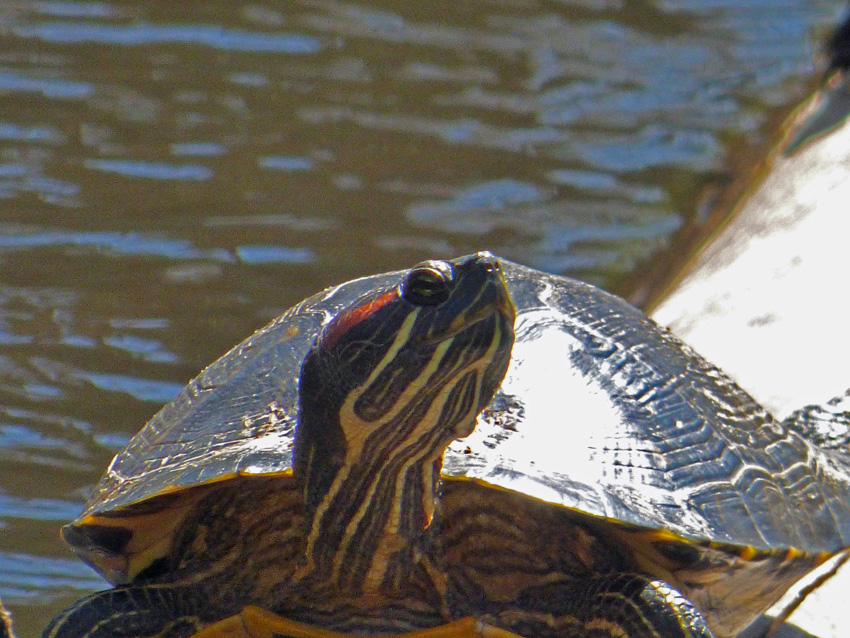 The red-eared slider originated from the area around the Mississippi River and the Gulf of Mexico, in warm climates in the southeastern corner of the United States. Their native areas include the southeast of Colorado, Virginia, and Florida. In nature, they inhabit areas with source of still, warm water, such as ponds, lakes, swamps, creeks, streams, or slow-flowing rivers. They live in areas of calm water where they are able to leave the water easily by climbing onto rocks or tree trunks so they can warm up in the sun. Many individuals are often found sunbathing together in a group or even on top of each other. They also require abundant aquatic plants, as this is the adults’ main food, although they are omnivores. Turtles in the wild always remain close to water unless they are searching for a new habitat or when females leave the water to lay their eggs.
The red-eared slider originated from the area around the Mississippi River and the Gulf of Mexico, in warm climates in the southeastern corner of the United States. Their native areas include the southeast of Colorado, Virginia, and Florida. In nature, they inhabit areas with source of still, warm water, such as ponds, lakes, swamps, creeks, streams, or slow-flowing rivers. They live in areas of calm water where they are able to leave the water easily by climbing onto rocks or tree trunks so they can warm up in the sun. Many individuals are often found sunbathing together in a group or even on top of each other. They also require abundant aquatic plants, as this is the adults’ main food, although they are omnivores. Turtles in the wild always remain close to water unless they are searching for a new habitat or when females leave the water to lay their eggs.
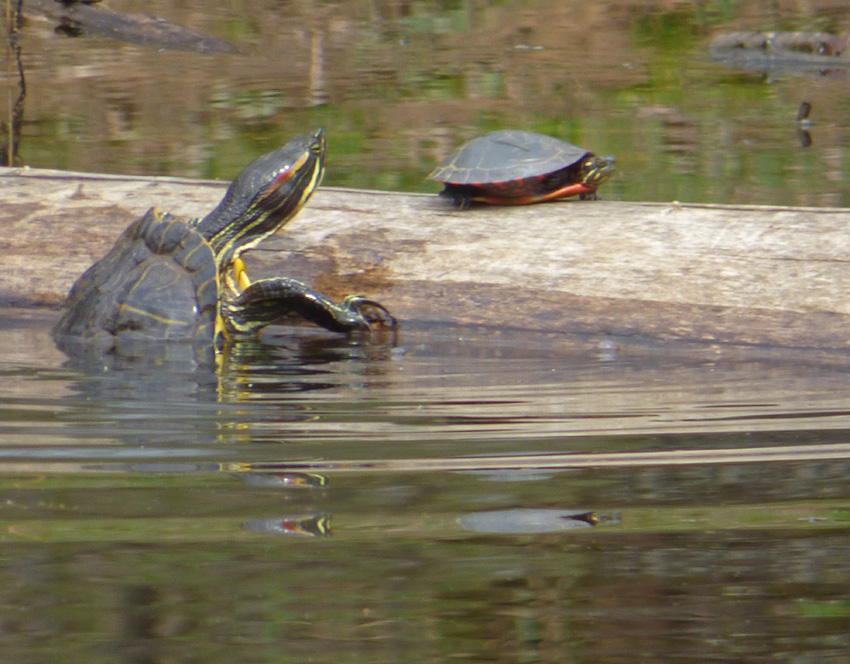 These turtles are “poikilotherms”, (cold blooded) so are unable to regulate their body temperatures independently; they are completely dependent on the temperature of their environments. For this reason, they continually need to sunbathe to warm themselves and maintain their body temperatures. Reptiles do not hibernate, but actually brumate, as they become less active, but occasionally rise to the surface for food or air. Brumation can occur to varying degrees. Red-eared sliders brumate over the winter at the bottom of ponds or shallow lakes; they become inactive, generally, in October, when temperatures fall below 50 °F. During this time, the turtles enter a state of sopor, during which they do not eat or defecate, they practically do not move, and the frequency of their breathing falls. Individuals usually brumate under water, but they have also been found under banks and hollow stumps and rocks. In warmer winter climates, they can become active and come to the surface for basking. When the temperature begins to drop again, however, they will quickly return to a brumation state. Sliders will generally come up for food in early March to as late as the end of April.
These turtles are “poikilotherms”, (cold blooded) so are unable to regulate their body temperatures independently; they are completely dependent on the temperature of their environments. For this reason, they continually need to sunbathe to warm themselves and maintain their body temperatures. Reptiles do not hibernate, but actually brumate, as they become less active, but occasionally rise to the surface for food or air. Brumation can occur to varying degrees. Red-eared sliders brumate over the winter at the bottom of ponds or shallow lakes; they become inactive, generally, in October, when temperatures fall below 50 °F. During this time, the turtles enter a state of sopor, during which they do not eat or defecate, they practically do not move, and the frequency of their breathing falls. Individuals usually brumate under water, but they have also been found under banks and hollow stumps and rocks. In warmer winter climates, they can become active and come to the surface for basking. When the temperature begins to drop again, however, they will quickly return to a brumation state. Sliders will generally come up for food in early March to as late as the end of April.
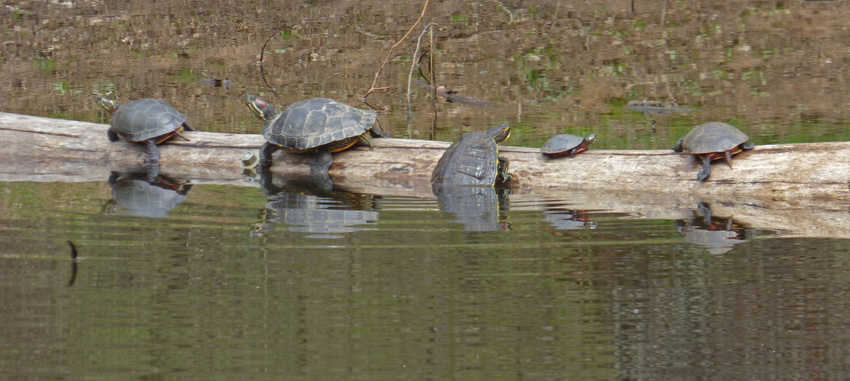
The red-eared slider is the most common type of water turtle kept as pets. Reptiles are asymptomatic carriers of bacteria of the genus Salmonella, meaning they don’t look or act sick themselves. This has caused justifiable concerns given the many references to infection of humans caused by the handling of turtles that has led to restrictions in the sale of red-eared sliders in the US. A 1975 U.S. Food and Drug Administration (FDA) regulation bans the sale (for general commercial and public use) of turtle eggs and turtles with a carapace length of less than 4 in. Some states have other laws and regulations regarding possession of red-eared sliders because they can be an invasive species where they are not native and have been introduced through the pet trade. Now, it is illegal in Florida to sell any wild-type red-eared slider, as they interbreed with the local yellow-bellied slider population.
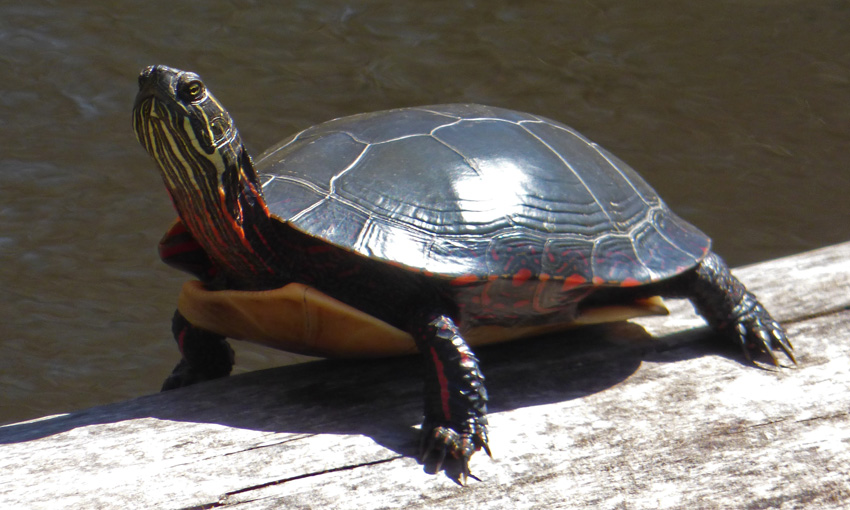 Eastern Painted Turtles are our most common turtle. There are four different sub-species of Painted Turtles in North America. Ours are the Midland variety. They breed in the Spring, and females dig nests from May to July. First, she will climb a little ways onto the shore. She will then dig a hole that is close enough to the water so that the bottom of the hole will have some water in it. The hole she digs will be about four inches deep. Next, she lays her eggs in the hole; each egg is about an inch long. The female then fills the hole back up to hide her nest. Painted turtles do not raise their young. Baby turtles will hatch and dig their way out of the nest in about 10 weeks. The sex of the turtles is decided by temperature. If the temperature in the nest was very warm, all the baby turtles will be females. If it wasn’t warm enough, then all the babies will be males. Many predators will eat the young turtles.
Eastern Painted Turtles are our most common turtle. There are four different sub-species of Painted Turtles in North America. Ours are the Midland variety. They breed in the Spring, and females dig nests from May to July. First, she will climb a little ways onto the shore. She will then dig a hole that is close enough to the water so that the bottom of the hole will have some water in it. The hole she digs will be about four inches deep. Next, she lays her eggs in the hole; each egg is about an inch long. The female then fills the hole back up to hide her nest. Painted turtles do not raise their young. Baby turtles will hatch and dig their way out of the nest in about 10 weeks. The sex of the turtles is decided by temperature. If the temperature in the nest was very warm, all the baby turtles will be females. If it wasn’t warm enough, then all the babies will be males. Many predators will eat the young turtles.
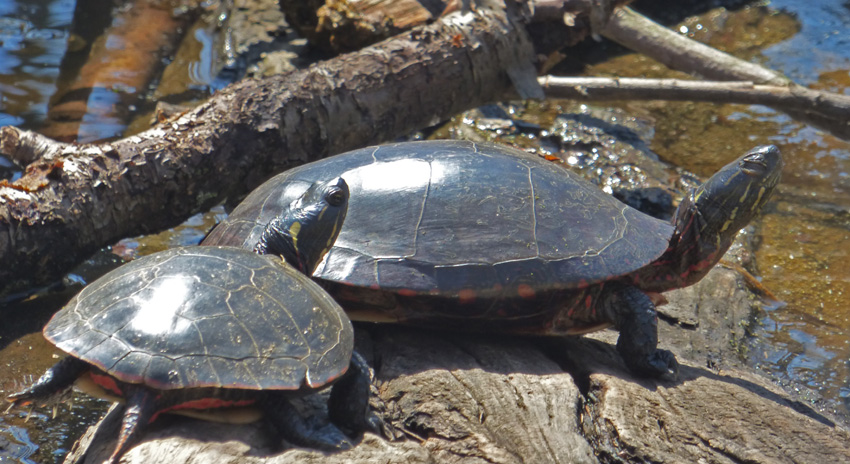 The turtle eats aquatic vegetation, algae, and small water creatures including insects, crustaceans, and fish. Although they are frequently consumed as eggs or hatchlings by rodents, canines, and snakes, the adult turtles’ hard shells protect them from most predators. Reliant on warmth from its surroundings, the painted turtle is active only during the day when it basks for hours on logs or rocks. During winter, the turtle hibernates, usually in the mud at the bottom of water bodies. The turtles mate in spring and autumn. Females dig nests on land and lay eggs between late spring and mid-summer. Hatched turtles grow until sexual maturity: 2–9 years for males, 6–16 for females.
The turtle eats aquatic vegetation, algae, and small water creatures including insects, crustaceans, and fish. Although they are frequently consumed as eggs or hatchlings by rodents, canines, and snakes, the adult turtles’ hard shells protect them from most predators. Reliant on warmth from its surroundings, the painted turtle is active only during the day when it basks for hours on logs or rocks. During winter, the turtle hibernates, usually in the mud at the bottom of water bodies. The turtles mate in spring and autumn. Females dig nests on land and lay eggs between late spring and mid-summer. Hatched turtles grow until sexual maturity: 2–9 years for males, 6–16 for females.

